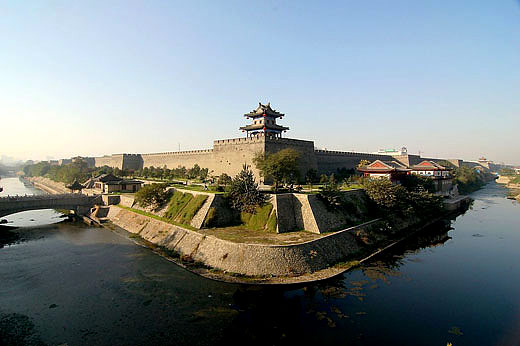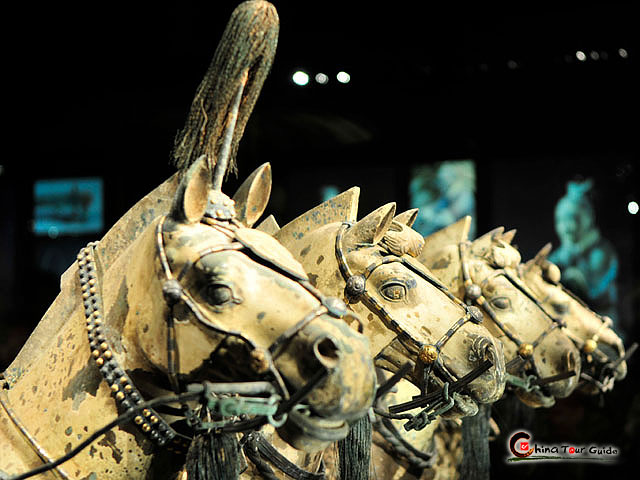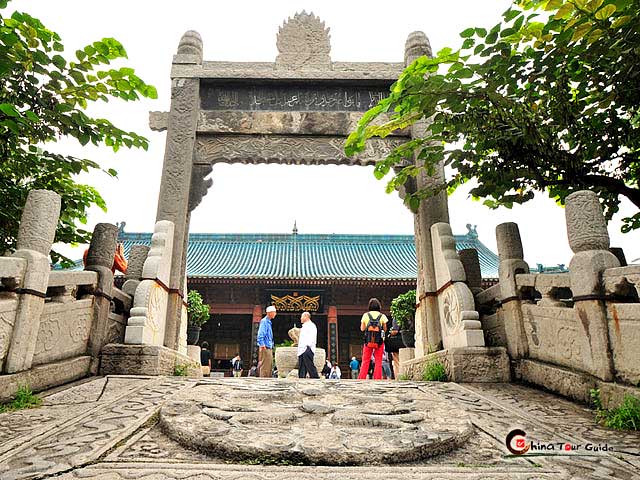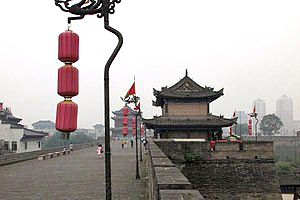Local Xi'an Tours
Terracotta Warriors (Terracotta Army)
To Chinese people, the social structure in the afterlife is exactly like that in the real world, especially in Qin Dynasty, the people regarded the death same as the life. Without question, The First Qin Emperor would like to build a similar empire for his afterlife at any cost. According to historical materials, there exist sun, moon, stars, rivers, mountains in his mausoleum. To protect the empire of his afterworld, an army could be a must. The Terracotta Army was concluded one of the parts of the Mausoleum of the First Qin Emperor.
The young emperor began the construction for his tomb when he was still alive in 215BC. A total of 720 thousands men, which occupied 3.6 percent of the total population in Qin Dynasty, spent 38 years to construct the project but still not finished until the dead of the Emperor. The stones for building the mausoleum were carried without any mechanical appliances from some mountains which are about 97 miles away from the tomb, and the materials for molding the terracotta warriors and horses are the “yellow earth” easily obtained nearby the mausoleum.
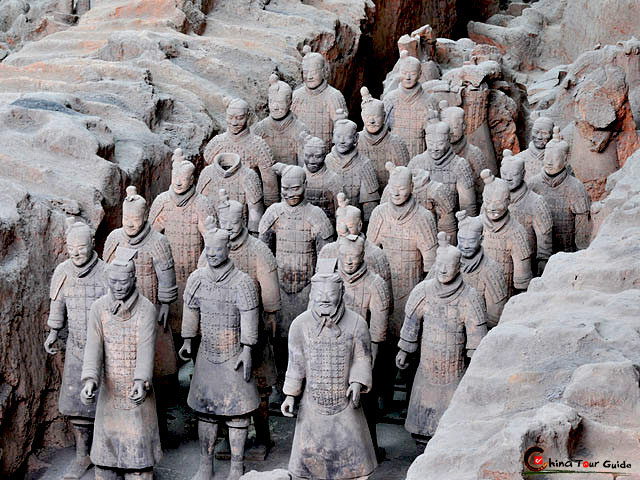 |
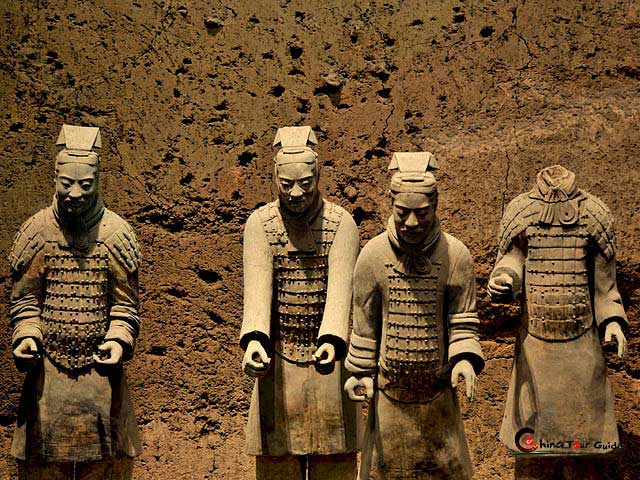 |
| Vanguard army alignment in Pit No. 1 | Terracotta Warriors was listed as UNESCO World Heritage in 1987. |
On 29th March 1974, the heavy drought ravaged Shaanxi province, 6 young farmers in Xiyang Village were sinking a well for irrigating fields. No water found even they dug into 4 meters beneath the ground. Suddenly, a human-shaped terra-cotta without head was found, then a awful head unearthed, then more and more broken terra-cotta figures, crossbows, bronze arrowhead were dug up. The confounded farmers opined that they might find an old abandoned temple and just threw away those broken figures into the wild and sold the bronze arrowhead to the salvage station.
Until 3 days later, Mr. Fang Shumin who was an irrigationist of the town inspected the aborted well and noted that it must be an ancient relic, and then he reported it to the local Cultural Center Office. The officials in the center sought all the discarded figures back and repurchased those bronze arrowheads, then kept them into the Cultural Center. After 2 month, Mr. Lin Anwen, a reporter from Xinhua New Agency, found those stored figures in the Culture Center and he realized that they must be the warriors from Qin Dynasty.
On 24th June 1974, he backed Beijing and reported it to the Central Government. Then a team of archaeologists was organized to Shaanxi, and the Terra-cotta Army finally came into the real world after 2000 years.
In the relic site, there are total 4 underground pits found and named Pit 1, Pit 2, Pit 3 and Pit 4 according to the unearthed sequence. Pit 4 has not been excavated and keeps empty. The other three pits were built with similar underground earth-and-wood structure but differed in layout. There are five sloping passages with clear trail of wheels on it around the pit. The terracotta figures were placed into the pottery-bricks-paved pit through the passage, then filled with rammed-earth and obturated the passages by stumpage. The pit sustained wood roof that was composed of huge and solid rafters, then covered by layers of fiber mats and earth. An underground military stronghold was finished.
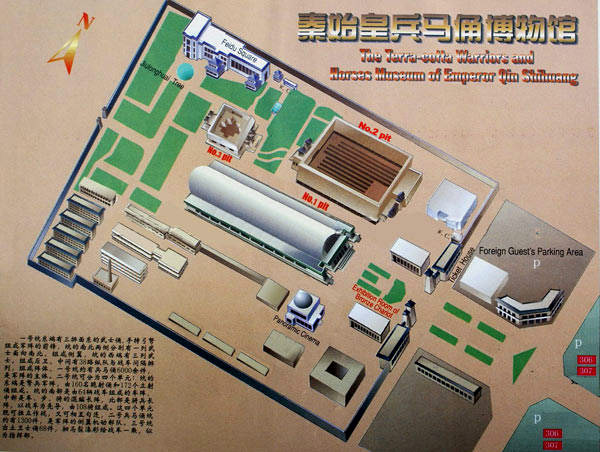 |
| The layout of Terracotta Army Museum including 3 pits. |
Those three pits actually is real military formation which fully reflect profound military strategy in Qin Dynasty. Pit 1 and Pit 2 are the attacking troops with different function that obey Pit 3’s order as their headquarter.
The layout of these three pits shaped like a flying goose, called “Goose Formation”. Pit 1, consists of large amount infantries and battle chariots, is the three times bigger than Pit 2. Pit 2 is the formation lined with archery, cavalry and battle chariots.
Approximately 40,000 bronze weapons have been unearthed from the terra-cotta pits, such as Ge, spear, halberd, Pi, Shu, battleaxe, sword, hook, bow, crossbow, arrowhead, etc. These weapons were exquisitely made through the processes of modeling, molding, casting and finishing, The surface of some weapons were plated with chrome-saline oxide coating, which has protected the sharpness of the weapons, this made them look as shiny as new when they were unearthed. Different proportion of the elements of the alloy was regulated for making different weapons. All these demonstrate that metallurgy of Qin ear reached a high level and the manufacture of weapons started to be standardized.
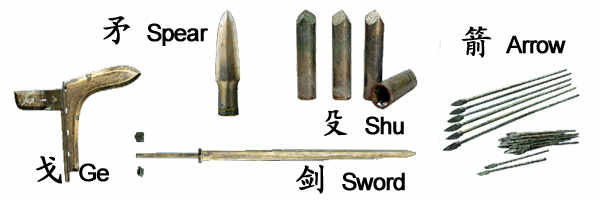 |
| All kinds of ancient weapons are found in the pits of Terracotta Army. |
Scientific testing reveals that the surface of the sword contains chromium, with a thickness of 10 to 15 micron, which acted as a protected coating against corrosion. The chrome-plating technolgoy was invented by the Germans, Americans in 1937 and 1950, but it had emerged in China 2200 years before.
The main tomb is not far from the excavated Terracotta Warriors and still remains relatively intact. The famous Chinese historian, Sima Qian, bewrited that the tomb includes replicas of palaces and scenic towers, rare utensils and wonderful objects, 100 rivers made with mercury, representations of 'the heavenly bodies', and crossbows rigged to shoot anyone who tried to break in. Modern archaeologists have discovered many evidences to testify the truth of the legend, while the Terracotta Army was one of the evidences.
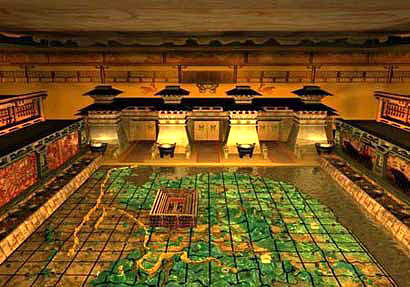 |
| All kinds of ancient weapons are found in the pits of Terracotta Army. |
Most of the workmen died from exhaustion or were killed for secrecy reason after finishing their work.
Select Other Favorite Attractions
|
|||||||||||||||||||||||||||||||||||
|
|||||||||||||||||||||||||||||||||||
|
|||||||||||||||||||||||||||||||||||
|
|||||||||||||||||||||||||||||||||||
|
|||||||||||||||||||||||||||||||||||
|
|||||||||||||||||||||||||||||||||||
Guide for China tour, offers most value & amazing experience. In China, you can rely on us
Copyright © 2001 - 2025. All Rights Reserved to ChinaTourGuide.Com
Hotel Guangzhou | Guizhou Tours | Hong Kong Hotels | 香港酒店 | 广州酒店 | 广州会议酒店 | Indochina Tour
Guide for China tours, offers most value & amazing experience. Chinatourguide.com. Your reliable China tour agency.

